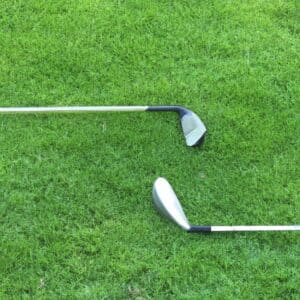Last Updated on June 7, 2023
Do you golf? If so, then you know that having the right equipment is vital to playing your best. One of the most important pieces of gear for any golfer is the shaft. But what exactly is a lite flex golf shaft? It can be confusing trying to make sense of all the different types and brands out there – but don’t worry; this article’s here to help! We’ll talk about what it is and why it might be the perfect option for your game. So keep reading if you want to learn more about lite flex golf shafts!
One type of shaft many golfers opt for when they’re shopping around is a lite flex golf shaft. This is because these are known as one of the lighter weight options on the market, helping them increase their club head speed while still maintaining accuracy and control over their shots. Lite flex also offers extra stability during swings due to its light construction, which reduces vibrations at impact. Plus, some models even feature additional features like graphite or titanium tips, giving players an even bigger boost in power.
So whether you’re just starting out or already have years under your belt, a lite flex golf shaft could be just what you need to take your game up a notch. In this article, we’ll go over exactly what makes lite flex special, plus provide some tips on how to choose the right one for your needs. Keep reading if you want to find out more!
Overview Of Golf Shafts
Golf shafts are one of the most important components of a golf club. They affect the performance and accuracy of shots, so selecting the right type is critical for any golfer’s game. Shaft construction plays an essential role in determining how each shot will be executed. There are three main types: steel, graphite, and lite flex. Steel shafts offer stability but lack flexibility; they are ideal for beginners or those with slower swing speeds. Graphite provides more forgiveness due to its lighter weight; it is suitable for intermediate players who want greater control over their shots. Lite flex shafts provide maximum power and distance; this option is best suited for advanced players with faster swings.
When choosing a golf shaft, several factors should be taken into consideration, such as playing ability, swing speed, frequency of use, and personal preference. Maintenance also needs to be considered since regular cleaning can extend the life of a shaft and ensure better performance over time. It’s important to select quality equipment that fits your style of play in order to maximize your potential on the course.
Construction Of Golf Shafts
Golf shafts are constructed from a variety of materials, including graphite and composite. Graphite is the most common material used for golf shaft construction as it provides great flexibility, allowing for more control over ball trajectory and spin rate. Composite shafts offer more weighting options to players who want greater distance or accuracy with their shots.
The type of material used can significantly affect performance:
Graphite
- Lightweight – Increases club head speed while still providing excellent stability
- Durable – Can withstand impact without breaking down under constant use
- Flexible – Allows for increased control when striking the ball
Composite
- Weighted – Heavier than graphite, this increases power and reach on each drive
- Resilient – Able to hold up against repeated impacts better than other materials
- Personalizable – Players can customize the weights in various areas to tailor their own equipment
No matter what material you choose, understanding how each type affects your game will help you improve your scores out on the course. To get the best results, find a combination that works for both your style and budget. With some trial-and-error testing, you’ll be able to find the perfect setup that takes your skills to the next level.
Types Of Golf Shafts

Golfers have a range of shaft options to choose from depending on their desired performance. Two types of materials are commonly used for golf shafts: graphite and steel. Graphite shafts generally provide more flexibility, making them advantageous for players with slower swing speeds who need extra help generating distance. Steel shafts tend to be heavier and stiffer, giving them greater accuracy, which makes them the preferred choice for low handicap players.
Shafts can also vary in weight, kick point, and torque rating – all factors that affect how a club behaves during your swing. Variable weighting allows you to adjust the overall balance of the club by changing its centre of gravity location or redistributing weight between the head and grip end of the club. The kick point is where the flex occurs as it stores energy and then releases it back into the ball at impact, resulting in an increase in power. Finally, a high torque rating indicates that there’s fewer twists when you hit off-centre shots due to higher stiffness levels. Understanding these components will help you find better suited clubs for your game.
Benefits Of Lite Flex Golf Shafts
Lite flex golf shafts are designed to improve your game. Their lightweight design makes them easier to swing and helps generate faster club head speed, resulting in increased accuracy and improved distance. With a lite flex shaft, you can expect a higher trajectory with greater control over the shot’s direction.
| Benefit | Description | Example |
|---|---|---|
| Lightweight | Less strain on arms for an effortless swing | Carbon fibre construction reduces the overall weight of the shaft by up to 10% compared to steel alternatives |
| Increased Accuracy | Optimized launch angle for straighter shots | Larger sweet spot improves consistency across all clubs in bag |
| Improved Distance | Increased ball velocity from fast clubhead speed | Unique Flex Profile maximizes energy transfer from hands to the ball during impact for longer drives |
| Higher Trajectory | For more carry off the tee box | Higher launch angle produces extra loft that gets the ball airborne quicker |
| Greater Control | More precision when aiming at target | Intuitive Feel System provides player feedback while swinging so they can adjust their aim accordingly before impact |
From beginners looking to get into golfing to experienced players seeking better performance, lite flex golf shafts provide tangible benefits that will improve one’s game. They make it easy to hit farther, straighten out errant shots and add height without sacrificing balance or control. All these improvements combine together towards making every round more enjoyable and rewarding – no matter what level of play you’re at.
Performance And Control Characteristics
A lite flex golf shaft is designed to offer a golfer enhanced performance and control characteristics. It has a softer flex than other types of shafts, allowing for more power when the club face meets the ball at impact. This results in greater distance off the tee and better accuracy with approach shots. Additionally, these lighter shafts provide added feel due to their decreased weight and flexibility. Golfers can benefit from increased accuracy and shot direction as well as improved timing by using this type of shaft.
The different flexes available in lite flex golf shafts also allow players to customize their clubs to suit their individual playing styles. With various choices ranging from regular or stiffer flexes to extra-stiff options, each player can find the perfect fit that caters best towards their swing speed, tempo, and release point. By tailoring their choice of equipment based on their own particular needs and preferences, they are sure to maximize their potential out on the course.
Swing Speed Considerations
When it comes to getting the most out of your golf game, understanding swing speed is key. A lite flex golf shaft can help increase club head speed and maximize ball distance. The primary benefit of a light flex shaft is that they are designed for players with slower swing speeds, allowing them to generate more clubhead speed without sacrificing accuracy. Additionally, these lighter-weight shafts allow for a smoother transition during the downswing, which helps maintain the swing tempo.
It’s important to note that when selecting a lite flex golf shaft, proper club fitting should be considered as well. Different players require different levels of stiffness in their clubs based on their individual swing speeds and experience level. For instance, an experienced player with faster swing speeds may need a stiffer shaft than someone just starting out who may have a slower swing speed. Ultimately, choosing the right shaft will depend on an individual’s unique needs and preferences when it comes to optimizing performance and control characteristics in their game. To ensure you pick the best shaft for your game, consider consulting with a professional club fitter or PGA pro before making any purchase decisions.
Maintenance And Care For A Lite Flex Shaft

Regular maintenance and care for a Lite Flex golf shaft are essential for its longevity. Golfers should take extra precautions to protect the shaft from dirt, debris, and other elements that can cause damage over time. The first step to properly maintaining a Lite Flex shaft is to clean it regularly with a soft cloth or brush. This will remove any dust and grime which could otherwise lead to rusting or wear on the shaft’s surface. Additionally, it’s important to avoid exposing the clubhead or shaft unnecessarily to moisture, as this can also impact its performance in the long term.
Finally, one of the most effective ways of protecting your lite flex shaft is by using a protective cover when not in use. These covers are designed specifically for golf clubs and provide an additional layer of protection against dirt and other external factors that may compromise the overall condition of your clubs. Taking these simple steps will ensure your lite flex shaft remains in top shape for many years to come!
Frequently Asked Questions
How Often Should I Replace My Lite Flex Shaft?
When it comes to lite flex golf shafts, understanding how often they need to be replaced is essential. It’s important for players to familiarize themselves with the replacement frequency of their lite flex club shaft in order to ensure proper performance and longevity. Understanding when a golf shaft needs to be replaced can also help improve accuracy and distance out on the course.
There are several factors that influence the recommended frequency of lite flex shaft replacement, including swing speed, playing conditions and overall usage rate. For example, if someone has a high swing speed or frequently plays in wet conditions, it may warrant more frequent shaft replacements than normal. Additionally, improper care, such as leaving clubs outside in humid weather, can have an effect on the necessary replacement schedule. Players should consult with retailers or experienced golfers for advice about what type of replacement schedule would suit them best based on their individual circumstances.
Knowing when it’s time to replace your lite flex club shaft will lead to improved performance and accuracy while on the links – not only helping you get better results but also extending the life of your equipment so you don’t have to buy new ones, too often! Taking good care of your gear combined with regularly assessing its condition is key when considering your own golf shaft replacement frequency.
What Is The Difference Between A Lite Flex Shaft And A Regular Flex Shaft?
When discussing the difference between a lite flex shaft and a regular flex shaft, it is important to consider several factors. The two major components of the comparison are the stiffness of the club head during impact with the ball and how much control you have over your shot. Lite flex shafts tend to be more flexible than regular flex shafts, allowing for increased power on shots while sacrificing some accuracy.
The primary benefit of having a lite flex golf shaft compared to a regular flex one is that they provide more distance off the tee as well as more forgiveness when addressing an imperfect strike at the ball. The greater flexibility also allows players to create their own spin on their shots, which can help improve accuracy in certain cases. On the other hand, regular flex shafts offer better control of trajectory due to their stiffer nature and less forgiving properties if there’s imprecise contact with the ball. Ultimately, it’s up to each individual golfer to decide what type of setup suits them best, depending on their personal playing style and skill level.
Conclusion
In conclusion, a lite flex shaft is an important piece of equipment for any golfer. It offers more distance than a regular flex and should be replaced every two to three years. Understanding the difference between these types of shafts can help you get the most out of your game. When shopping for clubs, make sure that you choose one with a lite flex shaft that matches your playing style and swing speed. Finally, it’s essential to keep your lite flex shaft clean and well-maintained in order to ensure optimal performance on the course.


